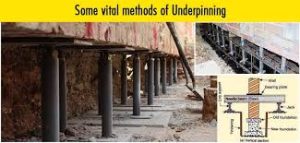Alright, let’s dive into the nitty-gritty of concrete underpinning without making it sound like we’re launching into space or entering a secret society. Think of underpinning as the unsung hero of the construction world. It’s kind of like that friend who always has your back, ensuring your house doesn’t decide to take a nap one fine day.

So, you’ve got an old house. It’s charming, full of character, and maybe a little crooked. One day, you notice cracks decorating your walls like modern art, and doors that seem to have developed a stubborn streak against closing properly. That’s your house hinting it might be time for some underpinning action.
Underpinning is essentially giving your home a new pair of shoes so it can stand tall and not wobble. There are different ways to do this, each as varied as pizza toppings (and everyone has their favorite).
First up is the classic method – mass concrete underpinning. This is old school but reliable. Imagine digging holes under your foundation and filling them with concrete in stages. It’s like patching up holes in jeans with fabric patches, but instead of denim, we’re using concrete.
Then there’s the beam and base method which sounds fancy because it kind of is. This involves sliding new beams underneath to give extra support where needed – think of it as adding extra legs to a wobbly table.
And for those who love a bit of tech in their lives, there’s resin injection underpinning. This involves injecting a special resin into the ground that expands and solidifies, propping up the building from underneath. It’s like filling a balloon with air so it rises up – except this balloon supports your home.
Deciding to go down the underpinning path isn’t something you wake up and decide over coffee. It usually comes after noticing things aren’t quite right or when planning an addition that requires stronger foundations.
The process kicks off with some detective work – testing soil and checking out what’s happening underground. Then comes figuring out which type of underpinning will save the day (or rather, save your house).
Why bother with all this? Because homes are more than just walls and roofs; they’re where memories are made. Plus, nobody wants to live in a leaning tower unless it’s Pisa.
Underpinning is about keeping stories alive while making sure tomorrow is safe and sound. It teaches us resilience – showing how we can adapt our spaces to work better for us.
So next time you see signs warning of underpinning works ahead, tip your hat (or nod if you’re not wearing one) to the silent guardians ensuring our buildings stay upright. And remember: behind every stable building is a tale of battling nature’s whims with wit and wisdom.
In short: Underpinning might not be glamorous or headline-grabbing stuff, but boy oh boy, does it play a crucial role in keeping our buildings standing strong against whatever Mother Nature throws at them!m. They’re not hunting for gold; they’re making sure our treasures – our homes – stay standing tall for years to come.
And hey, if nothing else, think of all the great “back in my day” stories you’ll have once it’s all done!ldings; they’re for life too–now how’s that for digging deep?ember: houses are more than just bricks and mortar; they’re stories in physical form. And sometimes those stories need a bit of help staying grounded–literally.